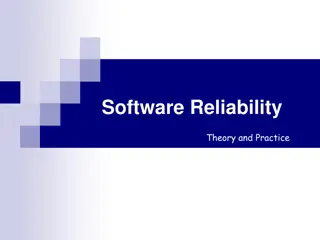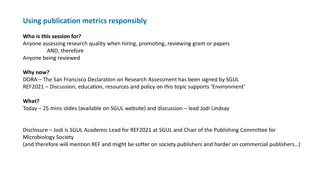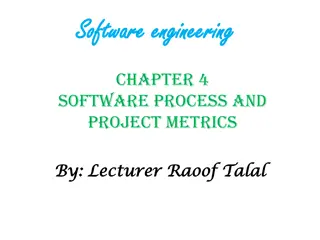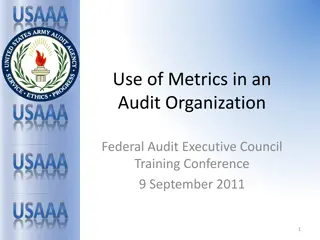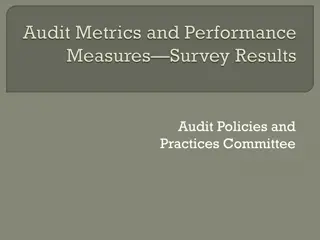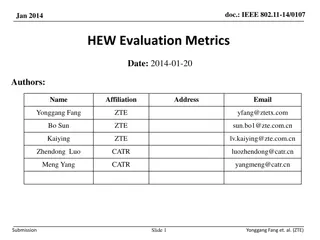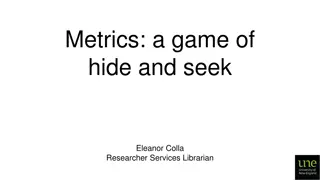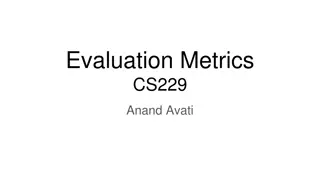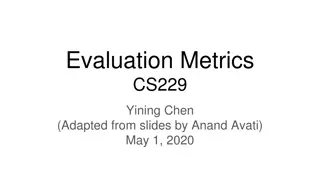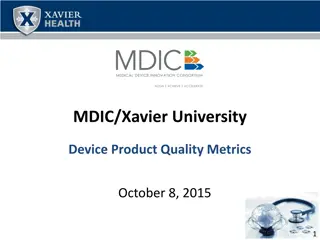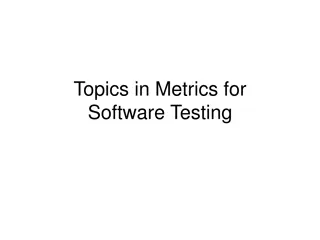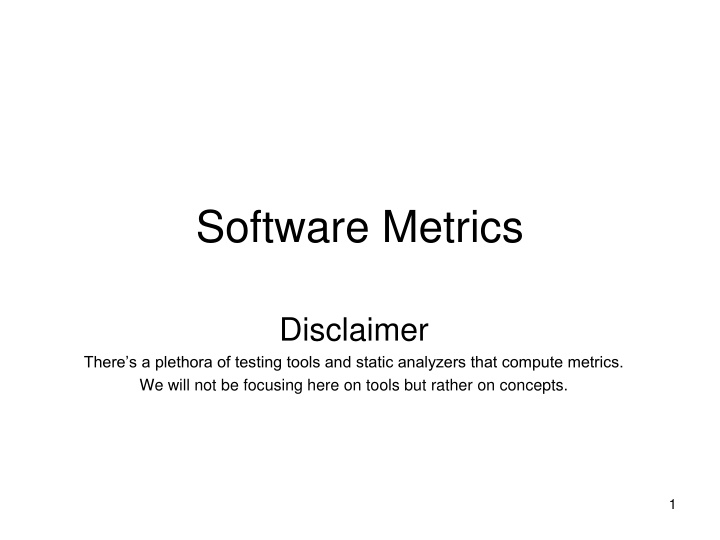
Software Metrics Concepts and Motivations
Explore the fundamental concepts of software metrics, including definitions, examples of metrics, and motivations for their use. Learn about different types of measures and the distinction between product and process metrics. Gain insights into why metrics are crucial for estimating project costs, improving quality, and forecasting future needs.
Uploaded on | 2 Views
Download Presentation

Please find below an Image/Link to download the presentation.
The content on the website is provided AS IS for your information and personal use only. It may not be sold, licensed, or shared on other websites without obtaining consent from the author. If you encounter any issues during the download, it is possible that the publisher has removed the file from their server.
You are allowed to download the files provided on this website for personal or commercial use, subject to the condition that they are used lawfully. All files are the property of their respective owners.
The content on the website is provided AS IS for your information and personal use only. It may not be sold, licensed, or shared on other websites without obtaining consent from the author.
E N D
Presentation Transcript
Software Metrics Disclaimer There s a plethora of testing tools and static analyzers that compute metrics. We will not be focusing here on tools but rather on concepts. 1
Definitions Measure - quantitative indication of extent, amount, dimension, capacity, or size of some attribute of a product or process. E.g., Number of errors Metric - quantitative measure of degree to which a system, component or process possesses a given (quality?) attribute. A handle or guess about a given (quality?) attribute. E.g., Number of errors found per person hours JP s take: metrics need interpretation 3
Motivation for Metrics Estimate the cost & schedule of future projects Evaluate the productivity impacts of new tools and techniques Establish productivity trends over time Improve software quality Forecast future staffing needs Anticipate and reduce future maintenance needs 4
Example Metrics Defect rates (where a defect is something less serious than an error wrt reqs) Error rates: Errors should be categorized by origin, type, cost It is a luxury to invest in root cause analysis Measured wrt: individual Module/class/procedure 5
Product vs. Process Process Metrics Insights of process paradigm, software engineering tasks, work product, or milestones Lead to long term process improvement Product Metrics Assess the state of the project Track potential risks Uncover problem areas Adjust workflow or tasks Evaluate teams ability to control quality 6
Types of Measures Direct Measures (internal attributes) Cost ($$), effort (in man/days), LOC (lines of code), response speed, memory footprint white box viewpoint Indirect Measures (external attributes) Functionality, complexity, efficiency, reliability, maintainability (more on this later in the course) Black box viewpoint Both pertain to quality? 7
Size-Oriented Metrics Size of the software produced: LOC - Lines Of Code KLOC - 1000 Lines Of Code SLOC Statement Lines of Code (ignore whitespace) Popular because easy to compute Typical Measures: Errors/KLOC, Defects/KLOC, Cost/LOC, Documentation Pages/KLOC 8
Complexity Metrics LOC - a rough function of complexity Halstead s Software Science (entropy measures, i.e., measures towards (quality?) equilibrium ) n1 - number of distinct operators n2 - number of distinct operands N1 - total number of operators N2 - total number of operands 9
Example if (k < 2) { if (k > 3) x = x*k; } Distinct operators: if ( ) { } > < = * ; Distinct operands: k 2 3 x n1 = 10 n2 = 4 N1 = 13 N2 = 7 10
Halsteads Metrics Amenable to experimental verification [1970s] Program length: N = N1 + N2 Program vocabulary: n = n1 + n2 Volume V = N * log2 n Difficulty D = (n1/2) + (N2/n2) Effort E = D x V Time to program T = (E / 18) seconds Number of delivered bugs B = V / 3000 (in ex: 20) (in ex: 14) (in ex: 76.14) (in ex: 6.75) (in ex:514) (in ex: 29 s) (in ex: 0.025) Welcome to the science of metrics, for which interpretation is often an art For example, D and E are taken to pertain to understandability 11
McCabes Complexity Measures McCabe s metrics are based on a control flow representation of the program. A control flow graph is used to depict control flow. Nodes represent processing tasks (one or more code statements) Edges represent control flow between nodes 12
Flow Graph Notation While Sequence If-then-else Until 13
Cyclomatic Complexity Defined as the set of independent paths through the control flow graph V(G) = E N + 2 E is the number of flow graph edges N is the number of nodes V(G) = P + 1 P is the number of predicate nodes 14
Example i = 0; while (i<n-1) do j = i + 1; while (j<n) do if A[i]<A[j] then swap(A[i], A[j]); end do; i=i+1; end do; 15
Flow Graph 1 2 3 7 4 5 6 16
Computing V(G) V(G) = 9 7 + 2 = 4 V(G) = 3 + 1 = 4 Basic paths are: 1, 7 1, 2, 6, 1, 7 1, 2, 3, 4, 5, 2, 6, 1, 7 1, 2, 3, 5, 2, 6, 1, 7 17
Meaning of V(G) Complexity increases with the number of decision paths and loops V(G) is a quantitative measure of the testing difficulty and, ultimately, an indication of reliability Experimental data shows value of V(G) should be no more then 10: testing is very difficult above this value 18
McClures Complexity Metric Complexity = C + V C is the number of comparisons in a module V is the number of control variables referenced in the module (from ifs and loops) Targets decisional complexity Somewhat pertains to path sensitization Similar to McCabe s but with regard to control variables. Can this be correlated to software quality? 19
A Comment McCall s quality factors were proposed in the early 1970s. They appear to be as valid today as they were at that time. It s likely that software built to conform to these factors will exhibit high quality well into the 21st century, even if there are dramatic changes in technology. 20
Quality Model (is ISO 9126 relevant to this?) product operation revision transition reliability efficiency usability maintainability testability portability reusability Metrics 21
High Level Design Metrics Structural Complexity Data Complexity System Complexity Structural Complexity S(i) of a module i. S(i) = fout2(i) Fan out is the number of modules immediately subordinate (directly invoked). 22
Design Metrics Data Complexity D(i) D(i) = v(i)/[fout(i)+1] v(i) is the number of inputs and outputs passed to and from i System Complexity C(i) C(i) = S(i) + D(i) As each C(i) increases the overall complexity of the architecture increases 23
System Complexity Metric Another metric: length(i) * [fin(i) + fout(i)]2 Length is LOC Fan in is the number of modules that invoke i The real question: what are good numbers for each of these metrics? 24
Coupling for a module Data and control flow: di input data parameters ci input control parameters do output data parameters co output control parameters (a key distinction) Global gd global variables for data gc global variables for control Environmental w fan in r fan out 25
Metrics for Coupling Mc = k/m, k=1 m = di + aci + do + bco + gd + cgc + w + r Key point: a, b, c, k can be adjusted based on actual data but how is this done? This computation can be so subjective that most will rely on simpler (if not simplistic) metrics 26
Component Level Metrics Cohesion (internal interaction) pertains to data members Coupling (external interaction) - a function of input and output parameters, global variables, and modules called Complexity of program flow - hundreds have been proposed (e.g., cyclomatic complexity) Cohesion difficult to measure Bieman 94, TSE 20(8) 27
Using Metrics The Process Select appropriate (??) metrics for problem Use metrics on problem Assess and generate feedback Steps: Formulation Collection Analysis Interpretation Feedback 28
Metrics for the Object Oriented Chidamber & Kemerer 94 TSE 20(6) Metrics specifically designed to address object-oriented software Class-oriented metrics: No need for procedure level metrics Cluster level metrics is simply too complex Simple direct measures 30
Chidamber and Kemerer Metrics Weighted methods per class (MWC) Depth of inheritance tree (DIT) Number of children (NOC) Coupling between object classes (CBO) Response for class (RFC) Lack of cohesion metric (LCOM) 31
Weighted methods per class (WMC) ci is the complexity of each method Mi of the class Often, only public methods are considered Complexity may be the McCabe complexity of the method Smaller values are better Perhaps the average complexity per method is a better metric n = i i c 1 = WMC 32
Weighted Methods per Class Viewpoints from Chidamber and Kemerer: -The number of methods and complexity of methods is an indicator of how much time and effort is required to develop and maintain the object -The larger the number of methods in an object, the greater the potential impact on the children -Objects with large number of methods are likely to be more application specific, limiting possible reuse 33
Depth of inheritance tree (DIT) For the system under examination, consider the hierarchy of classes DIT is the length of the maximum path from the node to the root of the tree Relates to the scope of the properties How many ancestor classes can potentially affect a class Smaller values are better 34
Number of children (NOC) For any class in the inheritance tree, NOC is the number of immediate children of the class The number of direct subclasses How would you interpret this number? A moderate (??) value indicates scope for reuse and high values may indicate an inappropriate abstraction in the design 35
Number of Children Viewpoints: As NOC grows, reuse increases - but the abstraction may be diluted Depth is generally better than breadth in class hierarchy, since it promotes reuse of methods through inheritance Really?? Open-closed principle? Does this not contradict heuristic for DIT? Classes higher up in the hierarchy should have more sub-classes then those lower down NOC gives an idea of the potential influence a class has on the design: classes with large number of children may require more testing 36
Coupling between Classes CBO is the number of collaborations between two classes (fan-out of a class C) the number of other classes that are referenced in the class C (where a reference to another class, A, is a reference to a method or a data member of class A) Viewpoints: High fan-outs denote class coupling to other classes/objects and thus are undesirable. High fan-ins denote good designs and a high level of reuse Not possible to maintain high fan-in and low fan outs across the entire system Excessive coupling indicates weakness of class encapsulation and may inhibit reuse High coupling also indicates that more faults may be introduced due to inter-class activities 37
Response for class (RFC) Mci: # of methods called in response to a message that invokes method Mi Fully nested set of calls Smaller numbers are better Larger numbers indicate increased complexity and debugging difficulties If a large number of methods can be invoked in response to a message, the testing and debugging of the class becomes more complicated n = i Mc i 1 38
Lack of cohesion metric (LCOM) Number of methods in a class that reference a specific instance variable A measure of the tightness of the code If a method references many instance variables, then it is more complex and less cohesive The larger the number of similar methods in a class the more cohesive the class is Cohesion of methods within a class is desirable, since it promotes encapsulation (??) 39
Lack of Cohesion in Methods LCOM poorly described in Pressman Class Ck with n methods M1, Mn Ij is the set of instance variables used by Mj 40
LCOM There are n such sets I1, , In P = {(Ii, Ij) | (Ii Ij ) = } //no common inst. var. Q = {(Ii, Ij) | (Ii Ij ) } If all n sets Ii are then P = LCOM = |P| - |Q|, if |P| > |Q| LCOM = 0 otherwise 41
Example LCOM Take class C with M1, M2, M3 I1 = {a, b, c, d, e} I2 = {a, b, e} I3 = {x, y, z} P = {(I1, I3), (I2, I3)} //those do not intersect Q = {(I1, I2)} //those that do Thus LCOM = 1 42
Explanation LCOM is the number of empty intersections minus the number of non-empty intersections This is a notion of degree of similarity of methods If two methods use common instance variables then they are (??) similar LCOM of zero is not maximally cohesive |P| = |Q| or |P| < |Q| 43
Class Size CS Total number of operations (inherited, private, public) Number of attributes (inherited, private, public) May be an indication of too much responsibility for a class 45
Number of Operations Overridden NOO A large number for NOO indicates possible problems with the design Poor abstraction in inheritance hierarchy 46
Number of Operations Added NOA The number of operations added by a subclass As operations are added the subclass moves away from the parent class As depth increases NOA should decrease 47
Method Inheritance Factor n = n C ( ) M i i MIF = . = i 1 1 i C ( ) M a i Mi(Ci) is the number of methods inherited and not overridden in Ci Ma(Ci) is the number of methods that can be invoked with Ci (see next slide) Md(Ci) is the number of methods declared in Ci (see next slide) 48
MIF Ma(Ci) = Md(Ci) + Mi(Ci) Meaning: All that can be invoked = (new or overloaded) + things inherited MIF is [0,1] MIF near 1 means little specialization MIF near 0 means large change 49
Coupling Factor _ ( , ) is client C C CF= . ( TC i j i j ) 2 TC is_client(x,y) = 1 iff a relationship exists between the client class and the server class. 0 otherwise (TC2-TC) is the total number of relationships possible (where TC is the # of classes) Entails relationships are not bidirectional Formula calculates xproduct - diagonal 50 CF is [0,1] with 1 meaning high coupling

